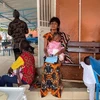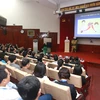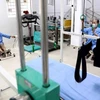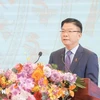A conference to promote cooperation in healthcare and nursing homes between Vietnam and Japan was held in Hanoi on February 5.
Event attendees included representatives from the Japanese Embassy in Vietnam, Japan International Cooperation Agency, Okayama University Hospital and local bodies in the field.
Deputy Minister of Health Nguyen Thi Xuyen regarded the conference as a good opportunity for Vietnam to learn from its guests’ experience in dealing with aging population along with providing healthcare service centres for the elderly.
Vietnam is still experiencing a “golden population structure” but its population is quickly aging and the proportion of elderly people will rise to 10.5 percent of the total population in a few years, making it one of the 10 most rapidly aging countries.
In Vietnam, the elderly bear “double health burdens” as disease patterns shift from communicable to non-communicable diseases and chronic illnesses, and cancer, stress and mental depression are becoming more frequent.
Such trends require higher healthcare expenditures, as the average treatment cost for an elderly individual is 7-8 times that for a child. As a person ages, their risk of disability increases, relegating them to time spent in bed.
Around 23.4 percent of elderly population find it difficult to perform daily activities with 90.67 percent of them needing assistance from others.
A research by the National Geriatric Hospital revealed that an elderly person suffers from an average of 3 chronic diseases simultaneously while those currently hospitalised often have up to 6 conditions at once.
Frailty, Alzheimer’s, malnutrition and mental depression are very common among older adults, especially those aged above 80.-VNA
Event attendees included representatives from the Japanese Embassy in Vietnam, Japan International Cooperation Agency, Okayama University Hospital and local bodies in the field.
Deputy Minister of Health Nguyen Thi Xuyen regarded the conference as a good opportunity for Vietnam to learn from its guests’ experience in dealing with aging population along with providing healthcare service centres for the elderly.
Vietnam is still experiencing a “golden population structure” but its population is quickly aging and the proportion of elderly people will rise to 10.5 percent of the total population in a few years, making it one of the 10 most rapidly aging countries.
In Vietnam, the elderly bear “double health burdens” as disease patterns shift from communicable to non-communicable diseases and chronic illnesses, and cancer, stress and mental depression are becoming more frequent.
Such trends require higher healthcare expenditures, as the average treatment cost for an elderly individual is 7-8 times that for a child. As a person ages, their risk of disability increases, relegating them to time spent in bed.
Around 23.4 percent of elderly population find it difficult to perform daily activities with 90.67 percent of them needing assistance from others.
A research by the National Geriatric Hospital revealed that an elderly person suffers from an average of 3 chronic diseases simultaneously while those currently hospitalised often have up to 6 conditions at once.
Frailty, Alzheimer’s, malnutrition and mental depression are very common among older adults, especially those aged above 80.-VNA



















